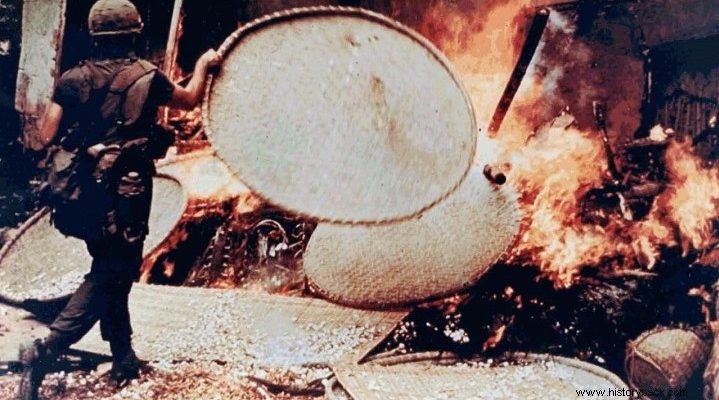
The war in Vietnam has been nicknamed "the dirty war," as if there had ever been a "clean" war in history. However, in Vietnam it was the nature of the struggle – guerilla warfare – that made it a hard, savage struggle from the start, beyond the rules of war.
Both sides, as almost always happens in a war, committed crimes, with the North Vietnamese clearly winning the upper hand. One of the reasons for their victory was the influence they had among the population, not because of their social proclamations, but because of the brutal terror they imposed. Each "reactive" was executed. In Hue alone, during the Tet attack, about 5,000 "dissidents" were executed.
The Americans reacted with the "Phoenix" program , the revelation of which caused an uproar in American public opinion, responding in kind to communist terrorism. But the South Vietnamese also practiced systematic terrorism against populations of dubious loyalty to the Saigon regime.
Also neither side seems to have taken much liking to rival prisoners, unless they were useful for propaganda or intelligence gathering – such as American captured pilots who fell into the hands of the North, or North Vietnamese autopilots who surrendered to the Americans.
The massacre
It should not be a coincidence that during Operation Junction City , the Americans reported that the enemy had 2,728 dead and only 34 prisoners. However, the event that forever marked the war in Vietnam is none other than the My Lai massacre.
On March 16, 1968 the 3rd Company of the 1st Battalion of the 20th Infantry Regiment he had just landed from helicopters near the then unknown Vietnamese village of My Lai. The company was led by a young reserve Lieutenant, William Calley .
Opinions about this particular officer are conflicting. His soldiers considered him "an incompetent, who could not even read a map." However, his superiors deemed him sufficient to assign him combat command.
Calley and his men moved towards the village where, according to the information they were given, Viet Cong insurgents were located. The information was probably correct because during its movement the company was fired upon by snipers, suffering casualties, while several men were wounded by traps. So when he finally entered the village everyone's nerves were tense and morale low.
However the search for the Viet Cong was unsuccessful – apparently if they did exist, they had escaped. Calley then ordered his men to execute all the Vietnamese in the village, a total of 347 souls, old men, women and children. The soldiers, some even reluctantly, obeyed and a blood orgy ensued. Several civilians were massacred with bayonets.
Young women were raped and then executed. Where the soldiers could not bear to face their victims, they locked them in huts and threw bundles of grenades inside. One soldier's description is shocking:“We rounded them all up and made them sit on the ground. Then Calley came and told us:"you know what you have to do".
“We said yes, thinking he meant we should just watch out for them. But after a while he came again and asked me why we hadn't killed them yet. "I want them dead," he said. Then I started shooting. I emptied four magazines onto the seated people ». The massacre was however covered up by the American Army.
Disclosure
About a year later, in April 1969, one of Calley's soldiers, Ronald Ridenhour , unable to bear the regrets, began, after returning home, to address open letters both to President Nixon and to leading American officials, as well as to the press. The letters caused a new uproar in American society.
Under the pressure of public opinion, the US Army was forced to form a commission of inquiry into the event. The interrogations continued until March 1970 and more than 400 witnesses were examined. Eventually charges were brought against 15 officers, Calley's superiors and of course himself. In the end, however, all the "big ones" were acquitted, without even being brought to trial.
Only Calley was tried and sentenced to life imprisonment, but was soon released. In fact, according to some, he was a hero, even compared to Christ! The Calley case, however, was not, as mentioned, the only one. On the same day, a few kilometers west of My Lai, 50 Vietnamese civilians were executed in cold blood by American soldiers.
Most surprising of all, however, was undoubtedly the report from Calley's commander-in-chief to American headquarters in Saigon. The report referred to the "Battle of Mi Lai", during which 128 Viet Cong were killed, but only 3 weapons were found. A similar report was made by SS general von Dem Bach Chelewski to Hitler in 1942, when he literally slaughtered about 4,000 Ukrainian civilians, but only discovered 82 weapons.
Consequences
The massacre of Mi Lai made a huge impression on the generally uneducated, "Hollywood" educated American society, which was used to seeing things in black and white, or in the most American sense of good cowboys and bad Indians.
The average American could not understand how his "good" countrymen behaved in such a way. And yet it was neither the first nor, unfortunately, the last time that the American Army committed war crimes.
Of course, this should not lead to the opposite conclusions, that is, the Americans were the "bad guys" and the North Vietnamese the "saints". In no war have there been, there are not and there will be no saints. After all, the Northerners also committed terrible crimes, both during and after the end of the war. Dozens of American prisoners of war were held in North Vietnam long after the war ended, creating a new legend, that of the missing Americans.
